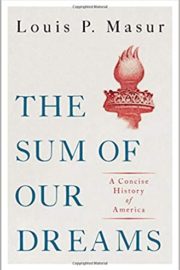Most concise histories leave out more than they include. I found the Sum of our Dreams to be an excellent book to read, and professor Masur conveyed the American experience concisely and clearly.

Contact US!
Have a question? Suggestion?
by Louis P. Masur
The Sum of Our Dreams: A Concise History of America by Louis P. Masur is a book I got through my membership at One Day University. Professor Masur is one of the best teaches that One Day University has. He is the Board of Governors Distinguished Professor of American Studies and History at Rutgers University.
Most concise histories leave out more than they include. I found the Sum of our Dreams to be an excellent book to read, and professor Masur conveyed the American experience concisely and clearly. The more recent history is complex as events like the Global War on Terror are still being analyzed and re-understood.
Evoking Barack Obama’s belief that America remains the “sum of its dreams,” Masur locates the origin of those dreams of freedom, equality, and opportunity and traces their progress chronologically, illuminating the nation’s struggle over time to articulate and fulfill their promise.
Masur lets the story of American tell itself. Inspired by James Baldwin’s observation that “American history is longer, larger, more beautiful and more terrible than anything anyone has ever said about it,” he expands our notion of that history while identifying its threads.
I recommend this book as well as any of Professor Masur’s lectures at One Day University.
by Joyce Carol Oates
 Reading Breathe by Joyce Carol Oates was a book I knew I needed to read once Jan was diagnosed. Although the book might trigger negative memories, I finally read Breathe. It was what I needed to read at this point in my journey.
Reading Breathe by Joyce Carol Oates was a book I knew I needed to read once Jan was diagnosed. Although the book might trigger negative memories, I finally read Breathe. It was what I needed to read at this point in my journey.
Ms. Oates wrote the book in 2019 after her husband, Charlie Gross, died. The novel is a story of love, loss, and loneliness, topics that I write about on this blog. I needed to read the book both for my mental health and for the readers of Sharing Jan’s Love.
The protagonist, Michaela, loses her husband while they are on a sabbatical in New Mexico. Her husband, Gerard, writes a book and teaches a class on memories. Jan and I never considered relocating before her illness, but this book convinced me that it would have aggravated my grief journey.
One of the parallels I observed while reading the novel is the similarity between Gerard’s reluctance to let family, friends, and co-workers know of his illness. Jan shared that reluctance in the early days, but I convinced her that the only chance of beating cancer was with the help of family and friends.
This dialogue could easily be one that Jan and I had.
Of course you want to summon his family—his (adult) children—but quickly, he says no.
Still waiting.
But – When?
Just not yet.
He is not an alarmist. (You are the alarmist.)
The novel is written in two parts – The Vigil and the Post-Mortem.
The opening paragraphs set the tone.
A Hand is gripping yours. Warm, dry hand gripping your slippery, humid hand.
Whoever it is urging you – Breathe!
Leaning over you begging you – Breathe!
As one mourning the death of the love of his life, I found several phrases in the book helpful in understanding what I have gone through and will continue to confront.
Among them is grief-vise, which I have written about in this stream.
In the grip of the grief vise, all that you will do, all that you even imagine doing, will require many times more effort.. Hardly daring to breathe for the grief-vise will tighten around your chest, squeezing the very air out of your lungs.
In the early stages of grief, the vise was strangling me. Breathing was impossible, and weeping was constant at times.
Michaela struggles with her grief. Seeing her husband every time she sees a man alone, even if they are older or younger than he was. I know I have felt Jan’s presence and still expect her to walk into our apartment.
Her struggles with a grief counselor and overly helpful friends are an experience I have not had but are familiar to those suffering from losing a loved one.
The last chapters are ones in which time becomes confusing and chaotic. At times, I was uncertain about which were real or imagined. The end, like all good novels, was ambiguous.
These are some of the other phrases I have found useful and will include in posts.
What you love most, that you will lose. The price of your love is your loss.
I recommend this book to all readers, even those struggling with grief.
When you buy a book or product using a link on this page, I receive a commission. Thank you for supporting Sharing Jan’s Love blog.
Subscribe to Sharing Jan's Love Newsletter!


by Rachel Blythe Kodanaz
Finding Peace, One Piece at a Time by Rachel Blythe Kodanaz is a book I wish I had long before Jan died. It provides helpful information on maintaining an organized lifestyle and handling a loved one’s possessions.
Having lost almost everything I had except for the clothes on my back after a house fire in 1972, I thought I had adopted a view that possessions were not significant. With Jan’s death, the truth is that she and I had collected essential possessions, and now it was my responsibility to decide what to do with them.
Rachel’s book is a practical guide, offering a comprehensive understanding of the significance of possessions and a step-by-step plan to manage them. Chapter 3, in particular, is a treasure trove of practical advice, focusing on Building Your Game Plan: The Ten Essentials and covering all the crucial topics – triggers, building a team, and creating a timeline, among others.
Magic of the Six Piles is a well-designed plan that will help most of us confront the possessions of our loved ones. The piles are:
Having absorbed the book’s wisdom, I am ready to transition from contemplation to action. This is how I sort my wife’s possessions into six piles. I am optimistic that it will also help me streamline my possessions, making books my trusted company more accessible for my sons.
Ms. Kodanaz has presented at my bereavement groups and has been an inspiration. She has also encouraged me to write about my love for Jan in a journal.


by Emma Donoghue
After Jan’s death and over two years of COVID, The Pull of the Stars might not seem like a good read for me. But I had placed this book on my to-read list a few months ago. The Pull of the Stars by Emma Donoghue is set in 1918 in Dublin; a maternity ward at the height of the Great Flu is a small world of work, risk, death, and unlooked-for love. It was a page-turner that engrossed me at that moment. When I reached the last page, I wanted the story to continue.
The details about childbirth, life, and death were riveting. All three of the main characters are ones that I could have imagined in an episode of Call the Midwife. That Dr. Lynn was a natural person underscores the depth of Ms. Donoghue’s research and writing skills.
Julie and Bridie’s characters were so real it was difficult to believe that they were not also based on natural persons.
I strongly recommend The Pull of the Stars.
The Goodreads summary provides an overview.
In an Ireland ravaged by war and disease, Nurse Julia Power works at an understaffed hospital in the city center, where expectant mothers who have come down with the terrible new Flu are quarantined together. Into Julia’s regimented world step two outsiders—Doctor Kathleen Lynn, a rumored Rebel on the run from the police, and a young volunteer helper, Bridie Sweeney.
With tireless tenderness and humanity, carers and mothers somehow do their impossible work. In the darkness and intensity of this minor ward, these women change each other’s lives in unexpected ways over three days. They lose patients to this baffling pandemic but shepherd new life into a fearful world.
In The Pull of the Stars, Emma Donoghue again finds the light in the darkness in this new classic of hope and survival against all odds.
When you buy a book or product using a link on this page, I receive a commission. Thank you for supporting Sharing Jan’s Love blog.
The Secrets We Left Behind by Soraya M. Lane is a historical fiction that raises the question, where were the women after Dunkirk and the fall of France? When World War II appeared to have been lost with a Nazi victory. Ms. Lane watched the movie Dunkirk and then researched that time and the women’s possible roles during that difficult moment in history.
She connected the evacuation at Dunkirk to the Massacre at Le Paradis, fifty miles away, to connect a British nurse and two French women whose strength helps them survive Nazi-occupied France. Three British male soldiers, two of whom survived the massacre and one who escaped Dunkirk, have secondary roles in the novel.
The Secrets We Left Behind is the story of the three strong women and their efforts to survive the occupation while hiding the three soldiers. This focus on the role of women has been long overdue in history. Ms. Lane, who studied to be a lawyer, has found a career as a writer. The Secrets We Left Behind is the first book I have read, but it will not be the last one by Ms. Lane that I read.
I strongly recommend this book!
The Goodreads synopsis provides an overview of the novel.
How far will they go for family, friendship, and love? Occupied France, 1940. When the staff at a field hospital draw straws to find out who will join the evacuation from Dunkirk, Nurse Cate is left behind. But when the Nazis arrive to claim prisoners of war, she takes her chance and flees into the night, taking one patient with her.
Fifty miles away, the surrendering soldiers of the Royal Norfolk Regiment are shot dead by the advancing Germans. Beneath the pile of bodies, two men survive, crawling to the safety of a nearby farmhouse, where sisters Elise and Adelaide risk their lives to take them in. When Cate, too, arrives at their door with her injured soldier, the pressure mounts.
The sisters are risking everything to keep their visitors safe. But with the Nazis coming ever closer and relationships in the farmhouse intensifying, they must all question the sacrifices they are willing to make for the lives of others. How far will they go for family, friendship, and love?
When you buy a book or product using a link on this page, I receive a commission. Thank you for supporting Sharing Jan’s Love blog.
by Kazuo Ishiguro
I started reading “Never Let Me Go” by Nobel Prize winner Kazuo Ishiguro today. This novel, listed among The New York Times 100 Best Books of the Century, has also received critical acclaim for its unique narrative and thought-provoking themes. Written by the acclaimed and bestselling author of “The Remains of the Day,” it’s described as “a Gothic tour de force” with an extraordinary twist—a moving, suspenseful, beautifully atmospheric modern classic.
The story unfolds at Hailsham, an enigmatic and exclusive boarding school in the English countryside. The central characters, Kathy, Ruth, and Tommy navigate through mercurial cliques and mysterious rules. Teachers constantly remind the students of their specialness, adding an element of suspense and intrigue to the narrative.
As young adults, Kathy, Ruth, and Tommy reunite, prompting Kathy to reflect on their shared past and understand what makes them unique. The novel explores themes of identity and humanity, delving into the emotional depth of their lives, making it a genuinely thought-provoking journey that readers can deeply connect with.
by Craig Wright
The Hidden Habits of Genius: Beyond Talent, IQ, and Grit―Unlocking the Secrets of Greatness by Craig Wright, Ph.D., I got through my membership in One Day University.
Dr. Wright raises many important questions as he analyses fourteen (14) critical traits of genius. Professor Craig Wright, creator of Yale University’s famous “Genius Course,” explores what we can learn from brilliant minds that have changed the world.
What we often presume about a genius does not match reality. Among other interesting observations, Dr. Wright reminds the reader that Picasso could not pass a fourth-grade math test, and Steve Jobs’s high school GPA was 2.65. He questions why to teach children to behave and play by the rules when transformative geniuses do not.
Examining the lives of transformative individuals ranging from Charles Darwin and Marie Curie to Leonardo Da Vinci and Andy Warhol to Toni Morrison and Elon Musk, Wright identifies more than a dozen drivers of genius, characteristics and patterns of behavior common to great minds throughout history. He argues that genius is about more than intellect and work ethic and that the famed “eureka” moment is a Hollywood fiction. Brilliant insights that change the world are never sudden, but rather, they are the result of unique modes of thinking and lengthy gestation.
I found the book to be a fascinating read and raised more questions for future thought and reading. Professor Wright argues that the habits of mind that produce great thinking and discovery can be actively learned and cultivated. In the book, he explains how. He notes that reading the book will not make you a genius but can “make you more strategic, creative, and successful, and, ultimately, happier.
by Octavia E. Butler
This morning, I completed reading Octavia E. Butler‘s acclaimed post-apocalyptic novel Parable of the Sower and immediately started reading its sequel, Parable of the Talents, initially published in 1998. This second book is even more relevant today than it was back then. The novel’s timely message of hope and resistance in the face of fanaticism is shockingly prescient.
In 2032, Lauren Olamina survived the destruction of her home and family. She envisioned a peaceful community in Northern California, which she established based on her newly founded faith, Earthseed. This new settlement provides a haven for outcasts who face persecution following the election of an ultra-conservative president. The new president pledges to “make America great again,” but the country becomes increasingly divided and dangerous. Lauren’s subversive colony, a minority religious faction led by a young black woman, becomes a target for President Jarret’s oppressive regime characterized by terror and discrimination.
In the future, Asha Vere discovers the journals of her mother, Lauren Olamina, whom she never met. As she delves into her mother’s writings, she grapples with the conflict between Lauren’s responsibilities to her chosen family and her mission to guide humanity toward a brighter tomorrow.
The Jan Lilien Education Fund sponsors ongoing sustainability and environmental awareness programs. Gifts made this month; I will match dollar-for-dollar. All donations are tax-deductible.
I receive a commission when you buy a book or product using a link on this page. Thank you for supporting Sharing Jan’s Love blog.
by Nathaniel Rich
Losing Earth: A Recent History by Nathaniel Rich reminds us how close we were to halting the climate emergency, and our failure has resulted in our passing the tilting point. The book “reveals, in previously unreported detail, the birth of climate denialism and the genesis of the fossil-fuel industry’s coordinated effort to thwart climate policy through misinformation propaganda and political influence.”
By 1979, we knew nearly everything we understand today about climate change – including how to stop it. Over the next decade, a handful of scientists, politicians, and strategists, led by two unlikely heroes, risked their careers in a desperate, escalating campaign to convince the world to act before it was too late. Losing Earth is their story and ours.
The New York Times Magazine devoted an entire issue to Nathaniel Rich’s groundbreaking chronicle of that decade, which became an instant journalistic phenomenon – the subject of news coverage, editorials, and conversations all over the world. In its emphasis on the lives of the people who grappled with the significant existential threat of our age, it made vivid the moral dimensions of our shared plight.
Losing Earth tells the human story of climate change in even richer, more intimate terms. It reveals, in previously unreported detail, the birth of climate denialism and the genesis of the fossil-fuel industry’s coordinated effort to thwart climate policy through misinformation propaganda and political influence. The audiobook carries the story into the present day, wrestling with the long shadow of our past failures and asking crucial questions about how we make sense of our past, our future, and ourselves.
Like John Hersey’s Hiroshima and Jonathan Schell’s The Fate of the Earth, Losing Earth is the rarest of achievements: a riveting work of dramatic history that articulates a moral framework for understanding how we got here and how we must go forward.
Losing Earth is a must-read book!